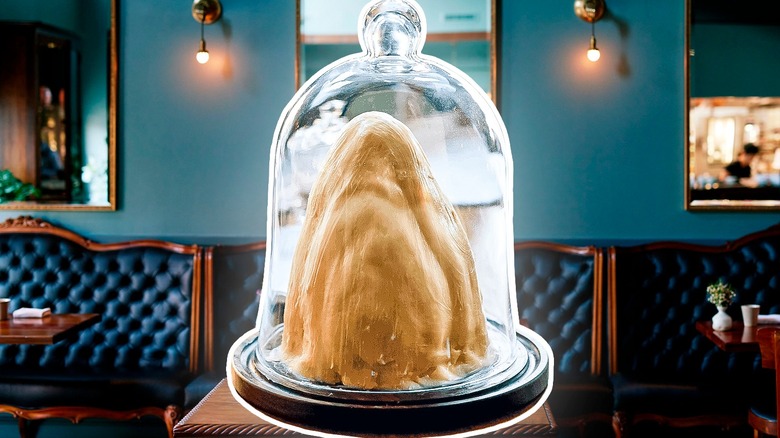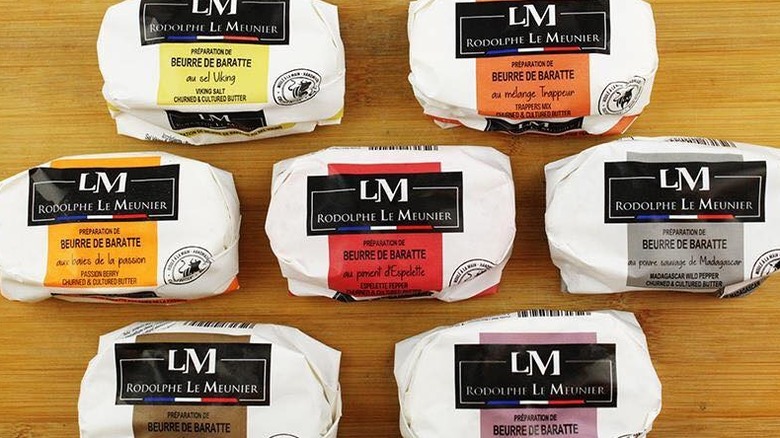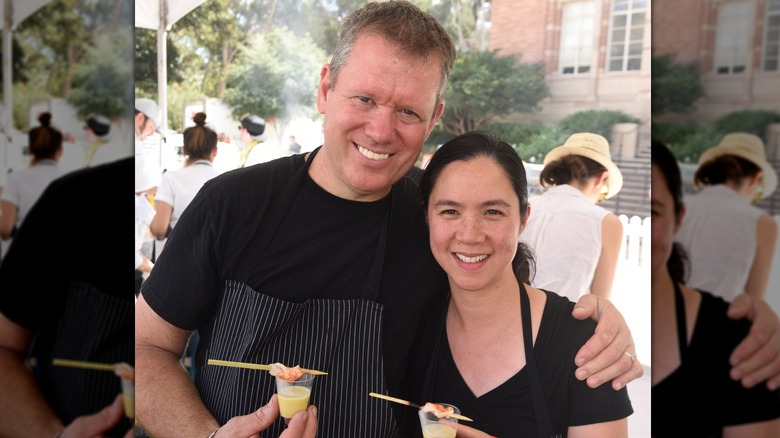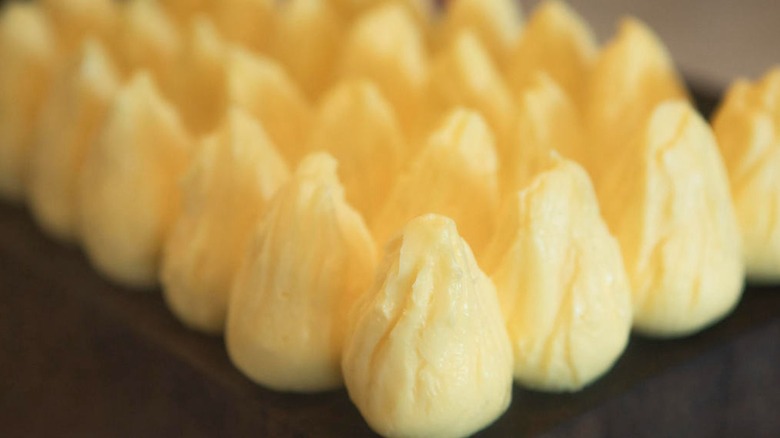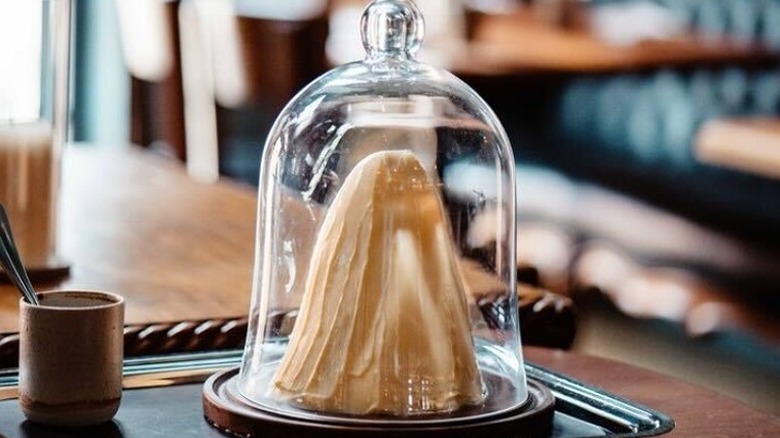How The Famous Butter Mountain At Manzke Restaurant Is Made And Served - Exclusive
Butter is a beloved ingredient. Besides the beautiful texture and taste it adds to the dishes that include it, even eating it alone with bread offers diners a delicious bite to indulge in before their food. Tasting this fatty, luxurious substance is one of the best parts of dining out, providing you know how to follow general bread and butter etiquette at restaurants.
At his eponymous LA restaurant Manzke, chef Walter Manzke has taken the traditional bread and butter starter one step further. Manzke has created a much-talked-about centerpiece to start off your meal, and it is styled as a mountain of butter. Visitors to the chef's famed République may recognize the version at Manzke as an enlarged version of the craggy butter served there.
Recently, Tasting Table spoke directly to the chef so that he could give us an insight into how he decided to serve this beloved concoction. Our goal was to understand why such a simple item has become so popular on a menu that is already stacked with many excellent and unique meals. If you haven't been to any of Chef Manzke's restaurants before, then studying the care, technique, and consideration he puts into something like the butter service may give you insight into why his restaurants are among the most highly regarded in the country.
The butter isn't just any butter
Chef Walter Manzke is always incredibly particular about where his ingredients come from, as he prides himself on sourcing the best of the best. Naturally, a chef like this doesn't use just any old butter in his restaurants. So, for the famous butter mountain, he favors a high-quality butter from La Croix-en-Touraine, France, that can be found on offer at all three of Manzke's LA establishments.
He said, "It's all served a little bit differently, but it's the same butter; it comes from Rodolphe Le Meunier in France." This isn't the first time we've heard of this top-quality ingredient, as other LA culinary legends like Nancy Silverton, the co-owner of Osteria Mozza and founder of La Brea Bakery, also favor this butter, made by the renowned cheesemaker of the same name.
Rodolphe Le Meunier produces its butter the traditional way, using a wooden butter churn and then employing knowledgeable workers to form it by hand. The creamery considers its process to be ancestral, with the end product being sold in only a few styles. Perhaps this is the reason so many expert chefs prize it.
Margarita Manzke makes all the bread in-house
It's clear from talking with chef Walter Manzke that the menu at both République and Manzke is a team effort. He is the first person to distribute credit for his restaurant's success. While speaking with Tasting Table, Manzke attributed another important and popular aspect of the butter service — fresh bread — to his partner. "We make all our bread here. My wife, Margarita, does that; as you know, she has a pretty good reputation for baking."
"Good reputation" is quite an understatement, as Margarita Manzke recently won the James Beard Award in 2023 for Outstanding Pastry Chef or Baker. Her influence is tangible across the restaurants, leading Walter Manzke to note how "bread has become a really important part of all our restaurants."
As it should be. In fact, Manzke's assessment may be considered an understatement. It's been previously said that pastries and baked goods are one of the things that kept République alive in its earliest years, allowing the eventual opportunity for a culinary ethos that culminates at Manzke. When it comes to Manzke, even the tallest and finest mountain of butter wouldn't be so sought after if customers had nothing special to pair it with.
The butter mountain is influenced by the butter making process
République loves to pay homage to how food is found, sourced, and created and how ingredients are made in the first place; butter mountain is no exception. The shape of it is inspired by the traditional process of churning butter by hand. Though you can make a version of butter at home, there really is no substitution for milk carefully churned and molded at a farm run by knowledgeable dairy artisans.
Chef Walter Manzke explained how the process affects the end result, "If you milk the cow and churn the butter by hand after the butter comes together, it has water in it," he said. "Take a towel or a cheesecloth, and you put the butter in it and twist it and squeeze it out to press the butter ... it separates from the fat, so that's the shape that you're left with, and it comes from that."
The chef wants to recognize the effort and craft that goes into making the butter by keeping it in a similar shape. By retaining the rustic structure that the butter holds while being crafted, customers can get an idea of the handmade origin of their meals.
Manzke serves butter mountain with a refined twist
If you happen to pop by the more intimate Manzke restaurant, you will get this mountain of Rodolphe Le Meunier butter served to you in a completely unique way. Don't worry, though; the quality of the raw ingredients is still top-notch. As chef Walter Manzke emphasized, "It's actually the same butter that I serve at République, Manzke, and Bicyclette."
The waiter will bring your butter service to you on a cart under a glass dome, where they will then scrape off the butter right then and there at the table. Manzke shared his thinking behind this process: "All that really does is ... gives the opportunity to tell the story about what the butter is. If you do it at the table, it creates the opportunity to learn something about it, to have a different experience with it."
As Manzke restaurant has approximately a dozen tables and a capacity of around 50 people, the environment gives the staff more face time with each diner, which is why the serving method at Manzke is better suited to creating a unique customer experience.
